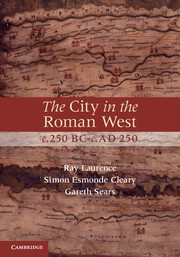Book contents
- Frontmatter
- Contents
- Illustrations
- Preface
- Introduction
- 1 The creation of an urban culture
- 2 Colonisation and the development of Roman urbanism
- 3 City foundation, government and urbanism
- 4 The reception of Roman urbanism in the West
- 5 Town planning, competition and the aesthetics of urbanism
- 6 Defining a new town: walls, streets and temples
- 7 Assembling the city 1: forum and basilica
- 8 Assembling the city 2: baths and urban life
- 9 Assembling the city 3: theatres and sacred space
- 10 Assembling the city 4: amphitheatres
- 11 The Roman city in c. AD 250: an urban legacy of empire?
- Bibliography
- Index
2 - Colonisation and the development of Roman urbanism
Published online by Cambridge University Press: 05 June 2012
- Frontmatter
- Contents
- Illustrations
- Preface
- Introduction
- 1 The creation of an urban culture
- 2 Colonisation and the development of Roman urbanism
- 3 City foundation, government and urbanism
- 4 The reception of Roman urbanism in the West
- 5 Town planning, competition and the aesthetics of urbanism
- 6 Defining a new town: walls, streets and temples
- 7 Assembling the city 1: forum and basilica
- 8 Assembling the city 2: baths and urban life
- 9 Assembling the city 3: theatres and sacred space
- 10 Assembling the city 4: amphitheatres
- 11 The Roman city in c. AD 250: an urban legacy of empire?
- Bibliography
- Index
Summary
The Romans of the Augustan Age identified the phenomenon of colonisation within their own history, according to which citizens or veteran soldiers were settled in captured cities or in cities established on new green-field sites. The legal status of a city as a colony or a municipium was important for the listing of cities by category. The first emperor attached greater importance to the colony than to the municipium. Contemporary historians, such as Livy or Velleius Paterculus, could look back and see colonisation as part of a process of Roman imperial expansion and as a way of understanding the spread of the Roman people across the Italian peninsula – something that needed to be remembered rather than forgotten. City foundation was a key aspect of Roman history and thus also of Roman identity.
- Type
- Chapter
- Information
- The City in the Roman West, c.250 BC–c.AD 250 , pp. 37 - 63Publisher: Cambridge University PressPrint publication year: 2011

